Lozzatronica
Member
- Messages
- 2
- Location
- London - Newham
Afternoon All,
I though it would make my first post here after spending a lot of time getting some good information from this site and you wonderful people.
For context, this is a Victorian mid terraced property me and my partner have just purchased a month ago. I am a structural engineer who specialises on pre-19th century buildings, and am soon going to be Care accredited, where i am lacking on, is shallow brick foundations which i do plan on getting up to speed with before the end of this year, but for now i am a bit uneducated on the matter.
Since moving in and getting to know the place, we've found that there has been a foul smell coming from the external gulley drain that collects a downpipe and kitchen waste from the rear of the property. CCTV survey not possible as our manhole cover has vanished under some concrete due to the previous owners back yard landscaping...
This drain is in its original form and is sadly in pretty poor condition. When I first looked at it, and the back yard, there is evidence that it has dropped somewhat, and the drainage solution that the previous owner had done was to lay concrete, all falling towards the house and the gulley. What this seems to have resulted in is water missing the gulley altogether, seeping around it into the earth and saturating the ground beneath the corner of the house.
I am planning to replace this drain, break out all the concrete in the back garden and lay some appropriate `brick paving, falling away from the house and some French drains to ensure that the ground will drain better (and look a lot nicer!) and in doing so also try and locate the manhole that they have so kindly concreted over. When digging it out, I found that the footing are very shallow, probably only a brick thick, and the soil / clay around this gulley was awful. some parts had the consistency of toothpaste, and what alarmed me is that the bricks in the corner of the footing, next to the gulley where practically loose.
I have opened up around the gulley, cleared around the footing to help it to dry out a bit. There is no sign of leaking, or cracks in the terracotta and running a bath, and all else (kitchen sink, toilets) does not introduce more water. I have reasoned that this is all due to poor pipe placement directing water around the gulley instead of into it and into the foundations. After going around all the walls with a level, and satisfying myself that they where all close to, or bang on vertical, i have planned by my actions and future plans so far:
1) Redirect all pipes so that they fall directly into the gulley and avoid going into the soil / concrete slab.
2) Excavate around the gulley up to the footings, cleaned of loose soil to allow it to dry out as much as possible.
3) I will be breaking out all the concrete, regrading the falls so they are directed away from the house and into a new drain system and laying a proper brick patio: 100mm Type 1 fill to develop correct falls, then a layer of sharp sand, then bricks with builders sand brushed between.
4) Replacing the now 140+ year old gulley with a modern Roddable Gulley.
5) I have installed crack monitors (as per the diagram) to keep an eye on settlement if it occurs due to drying out of the ground.
My questions to this community are as follows:
A) Long term, what are the implications of the saturated ground drying out? Will any settlement stop? There have been some cracks that look to have appeared in the last 30+ years (marked up in one of the images).
B) We are planning to do some larger scale refurbishments down the line. If i do need to underpin, is it better to wait until then so it can all happen at the same time?
C) Almost all of this beyond the line "there is some indication of movement, but appears to be historic" was missed by our surveyor. Would it be a good idea to approach our insurers now? Or if i start to notice some indication on the crack gauges.
D) Is there anything that i should be alarmed about which need immediate structural solutions? Or can these old houses take it on the chin. The number of period property's that i have surveyed that have clear signs of historic subsidence that are still solid and safe suggest that i shouldn't be too concerned for now.
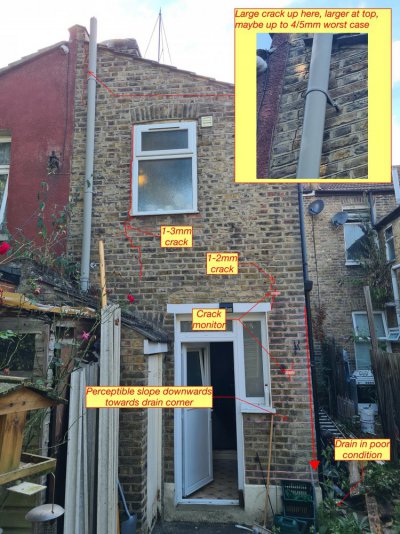
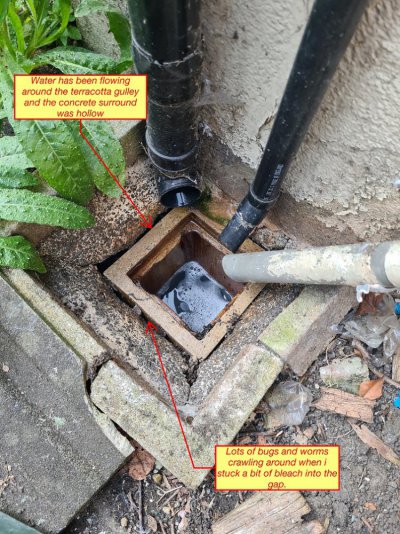
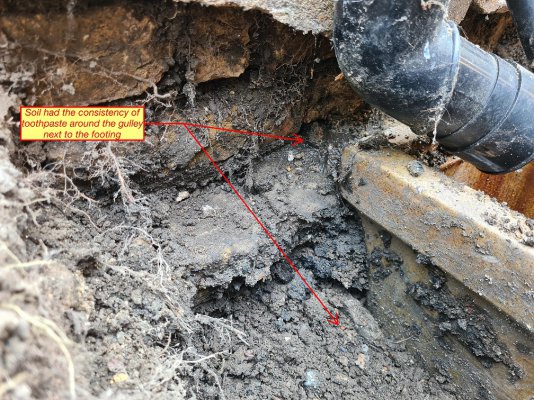
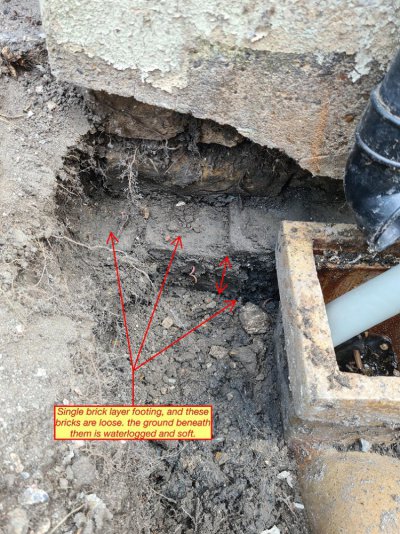
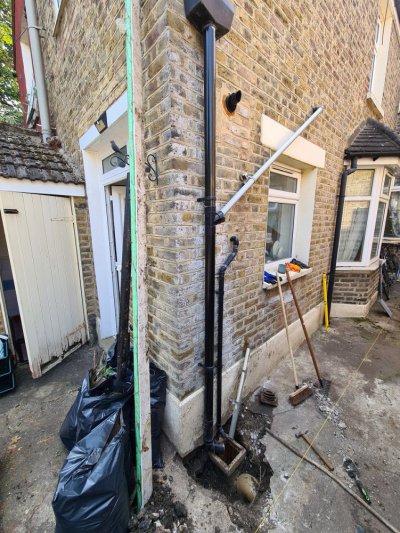
I though it would make my first post here after spending a lot of time getting some good information from this site and you wonderful people.
For context, this is a Victorian mid terraced property me and my partner have just purchased a month ago. I am a structural engineer who specialises on pre-19th century buildings, and am soon going to be Care accredited, where i am lacking on, is shallow brick foundations which i do plan on getting up to speed with before the end of this year, but for now i am a bit uneducated on the matter.
Since moving in and getting to know the place, we've found that there has been a foul smell coming from the external gulley drain that collects a downpipe and kitchen waste from the rear of the property. CCTV survey not possible as our manhole cover has vanished under some concrete due to the previous owners back yard landscaping...
This drain is in its original form and is sadly in pretty poor condition. When I first looked at it, and the back yard, there is evidence that it has dropped somewhat, and the drainage solution that the previous owner had done was to lay concrete, all falling towards the house and the gulley. What this seems to have resulted in is water missing the gulley altogether, seeping around it into the earth and saturating the ground beneath the corner of the house.
I am planning to replace this drain, break out all the concrete in the back garden and lay some appropriate `brick paving, falling away from the house and some French drains to ensure that the ground will drain better (and look a lot nicer!) and in doing so also try and locate the manhole that they have so kindly concreted over. When digging it out, I found that the footing are very shallow, probably only a brick thick, and the soil / clay around this gulley was awful. some parts had the consistency of toothpaste, and what alarmed me is that the bricks in the corner of the footing, next to the gulley where practically loose.
I have opened up around the gulley, cleared around the footing to help it to dry out a bit. There is no sign of leaking, or cracks in the terracotta and running a bath, and all else (kitchen sink, toilets) does not introduce more water. I have reasoned that this is all due to poor pipe placement directing water around the gulley instead of into it and into the foundations. After going around all the walls with a level, and satisfying myself that they where all close to, or bang on vertical, i have planned by my actions and future plans so far:
1) Redirect all pipes so that they fall directly into the gulley and avoid going into the soil / concrete slab.
2) Excavate around the gulley up to the footings, cleaned of loose soil to allow it to dry out as much as possible.
3) I will be breaking out all the concrete, regrading the falls so they are directed away from the house and into a new drain system and laying a proper brick patio: 100mm Type 1 fill to develop correct falls, then a layer of sharp sand, then bricks with builders sand brushed between.
4) Replacing the now 140+ year old gulley with a modern Roddable Gulley.
5) I have installed crack monitors (as per the diagram) to keep an eye on settlement if it occurs due to drying out of the ground.
My questions to this community are as follows:
A) Long term, what are the implications of the saturated ground drying out? Will any settlement stop? There have been some cracks that look to have appeared in the last 30+ years (marked up in one of the images).
B) We are planning to do some larger scale refurbishments down the line. If i do need to underpin, is it better to wait until then so it can all happen at the same time?
C) Almost all of this beyond the line "there is some indication of movement, but appears to be historic" was missed by our surveyor. Would it be a good idea to approach our insurers now? Or if i start to notice some indication on the crack gauges.
D) Is there anything that i should be alarmed about which need immediate structural solutions? Or can these old houses take it on the chin. The number of period property's that i have surveyed that have clear signs of historic subsidence that are still solid and safe suggest that i shouldn't be too concerned for now.





